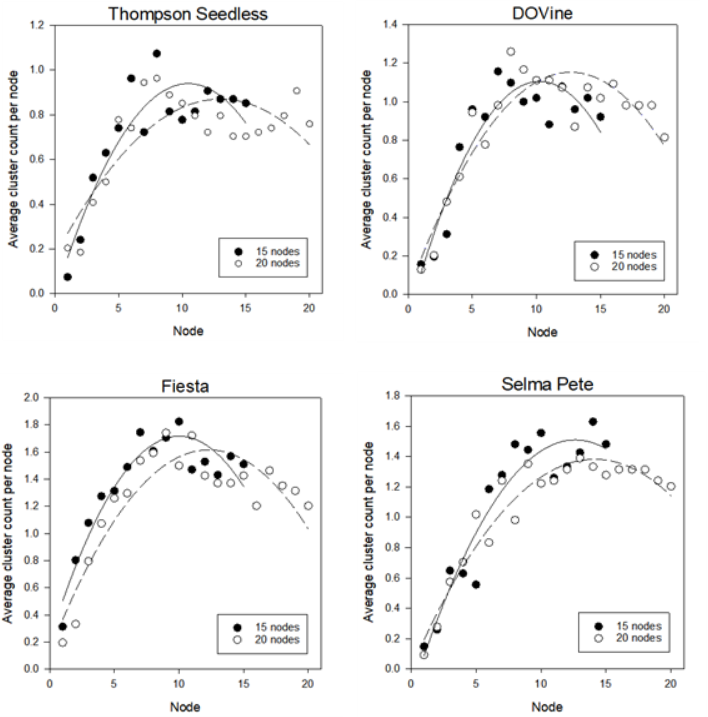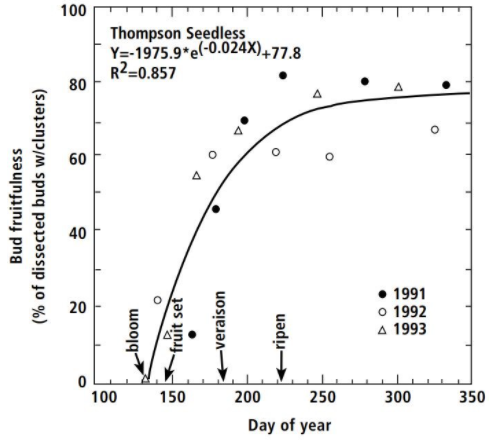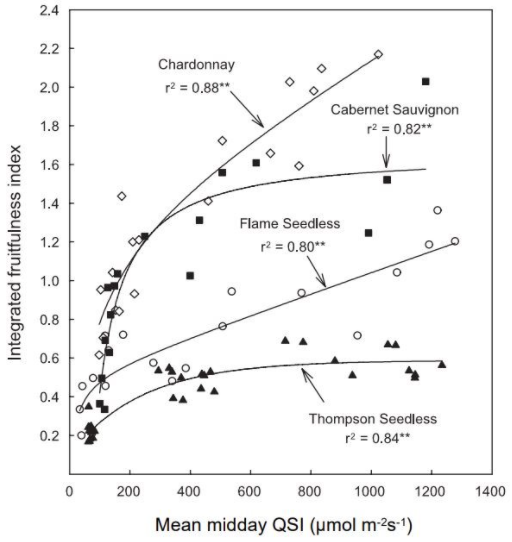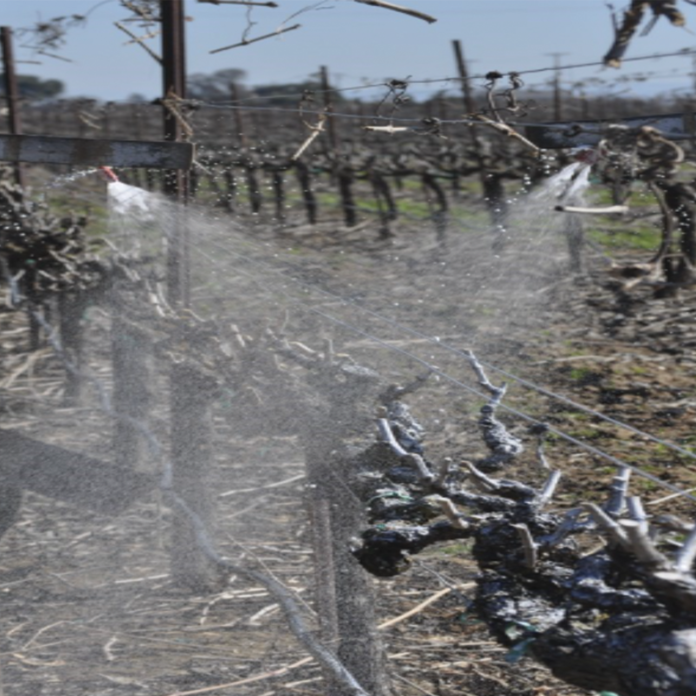Pruning and disease management are important vineyard practices that need attention in the dormant season. Pruning directly affects the upcoming season’s potential yield and quality and can directly and indirectly affect the vineyard’s long-term productivity. Pruning practices, and the care of pruning wounds, can also help manage trunk diseases. Pruning practices that optimize productivity and quality, and protect against trunk disease, will help extend the productive lifespan of vineyards.
Dormant Pruning and Yield Management
Grapevines are pruned for three main reasons:
- To keep the vine in a shape that conforms to the trellis system and facilitates vineyard operations.
- To remove old wood and retain fruiting canes or spurs for the current season crop, plus spurs for future wood placement.
- To select a quantity and quality of fruiting wood that is in balance with vine growth and capacity.
The choice of pruning method is largely influenced by fruitfulness characteristic of vine variety. For instance, most raisin varieties are cane pruned because their basal buds produce shoots with fewer and smaller clusters than apical buds (Fig. 1). In contrast, most wine varieties are spur pruned, since most wine varieties have adequate basal bud fruitfulness and spur pruning is less laborious and costly than cane pruning. However, cane pruning is sometimes preferred for certain wine varieties, like Carmenere, which have low basal bud fertility, or in cool climate regions where cool spring weather might reduce basal bud fruitfulness in other varieties. Understanding the factors determining the bud fruitfulness provides insight as to the best pruning practice for a given vineyard.

Grapevine yield is formed over a two-year cycle that begins with the initiation of cluster primordia within compound buds. Cluster primordia are initiated in basal buds first, around bloom time, with more apical buds forming cluster primordia in succession, and most buds having formed whatever cluster primordia they will have by veraison (Fig. 2). Sunlight promotes cluster initiation, so sunny, warm weather between bloom and veraison helps maximize cluster primordia formation, whereas cool and cloudy weather can lead to less fruitful buds (Fig. 3). Because basal buds tend to form cluster primordia earlier than the apical buds, spring weather can have a greater impact on the fruitfulness of some varieties than others. For example, cane-pruned varieties initiate cluster primordia over a longer time period than spur-pruned varieties.


Raisin growers have long been advised to retain “sun” canes, which generally have more fruitful buds than “shade” canes. Cane and spur morphology can also indicate potential fruitfulness. Mature, round canes and spurs having moderate thickness and internode length are often the most fruitful. Narrow canes and spurs often indicate weak growth with inadequate starch content to support cluster primordia formation. In contrast, exceptionally thick canes with long internodes and a flattened shape, commonly referred to as “bull” canes, may also be expected to have poor fruitfulness. Stressed vines may have insufficient carbohydrate content to support maximum bud fruitfulness. Insufficient water, inadequate nutrition and poorly managed pest or disease issues (e.g. nematodes and powdery mildew) can all stress the vines and reduce bud fruitfulness. As previously mentioned, node position also affects fruitfulness, cluster size and fruit quality of cane-pruned varieties. Leaving longer canes could increase yields if the vines do not become overcropped.
Cluster initiation is generally completed by veraison, so, by late summer, the number of clusters a designated bud may have in the following season has already been determined. Therefore, before pruning, growers can collect and dissect representative buds from a vineyard and observe and count the cluster primordia with the aid of a dissecting microscope. This information may be used to help predict yield potential and adjust their pruning severity to help achieve a desired number of clusters per vine. As growers gain experience with this method, it might also help them adjust their canopy or irrigation management practices to help improve fruitfulness, since shoot exposure to light improves bud fruitfulness.
After a pruning strategy has been decided on, and the vines were pruned, the maximum potential number of clusters per vine has been fixed. One of the main goals of pruning is to retain the optimal number of buds per vine to regulate the crop size. If too many buds are retained after pruning, the vines may become overcropped, leading to poor canopy growth, unripe fruit and possible carry-over effects on the following year, resulting in erratic and delayed budbreak, slow canopy growth and poor yield and fruit quality. In contrast, if too few buds are retained, the vines may be undercropped, resulting in suboptimal yield and excessive canopy growth, which can cause self-shading, reducing fruit quality. Therefore, understanding bud fertility and potential crop load can help inform pruning decisions and thereby optimize yield and quality.
Disease Management
Pruning practices also have implications for grapevine trunk diseases, which can seriously reduce vineyard productivity. Trunk diseases are caused by different fungi including Esca or black measles, Botryosphaeria (Botryosphaeria canker), Eutypa lata (Eutypa dieback) and Phomopsis viticola (Phomopsis cane and leaf spot). All of these fungi can enter the vines through pruning wounds, especially after precipitation. After a fungal infection has been initiated, it grows toward the roots, slowly killing the vascular tissue, decaying the wood and eventually killing the vines. The typical symptoms from trunk-diseased vines are cankers, dead arms and cordons, and trunks, with vines collapsing in a few years. The economic loss can be dramatic, and trunk diseases may significantly reduce the productive life of vineyards.

Pruning methods can affect the potential disease risk. Cane pruning typically has less trunk disease risk than spur pruning systems since cane pruning leaves fewer pruning wounds than spur pruning. The best mitigation strategy for trunk disease is prevention. Selective pruning, sometime referred to as “vine surgery”, can remove infected wood, sometimes resolving an established infection. However, vine surgery is laborious and will not be effective unless all the diseased wood is removed. Retraining may be needed to replace arms or cordons removed in surgery, and the surgery will result in large, open pruning wounds that could easily become infected if not protected with pruning protectants. The labor cost to renew the cordon or trunk is typically economically prohibitive in the San Joaquin Valley, and it also does not offer the long-term solution, since those fungi can slowly reinfect the vine if complete elimination of diseased wood was not achieved by the vine surgery. The current preventative measures include double pruning or delay pruning, pruning wound protection and vineyard sanitation.
Double pruning or delayed pruning helps prevent the exposure of final pruning wounds until February or March when most rain events finish and weather is warming. Less rain with warm weather helps the vines seal the pruning wounds and prevent the fungi entering through pruning cuts. However, double pruning or delayed pruning does have some barriers for some growers to adopt (e.g. pre-pruner and labor availability). For growers who can adopt it, double pruning or delayed pruning offers an effective way to minimize trunk disease.
Pruning wound protectants (mostly fungicides) are another option when double pruning or delayed pruning is impractical. Dr. Akif Eskalen, UC Davis, has been evaluating different pruning wound protectants in California since 2019, and the results from those trials can be found here: ucanr.edu/sites/eskalenlab/Fruit_Crop_Fungicide_Trials/. Fungicide efficacy is variable, but the application of pruning wound protectants before the rain event can help prevent the fungal infections. However, pruning wound protectants cannot provide complete protection, and we still do not know how long the protection lasts after the spray. More than one spray might be needed if rain events occur more frequently after pruning.
Vineyard sanitation should be also integrated into the trunk disease management plan. Because numerous fruiting bodies can be found on pruning debris left in the vineyard, complete destruction is desirable to reduce the source of inoculum and avoid new infections. An extensive sanitation of the vineyard should be practiced, keeping the inoculum level as low as possible. This can be accomplished by pruning out all diseased wood, removing it from the vineyard and destroying it by burning or burying.
Recently, mechanical pruning has become more popular due to the increased cost and declining availability of farm labor. However, mechanical pruning may leave more than double the number of spurs per vine compared to traditional hand pruning. Delayed pruning or pruning wound protectants should be applied after pruning to reduce the risk of trunk disease. In all, trunk disease does not only affect this year or next year’s yield and general vine health, but also reduces the longevity of vineyard production life.













